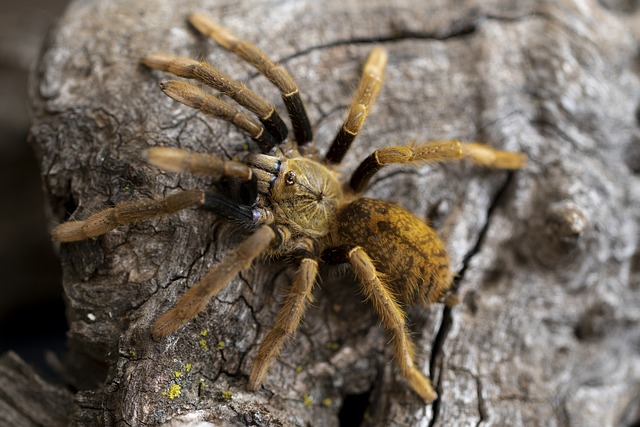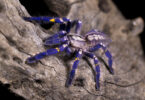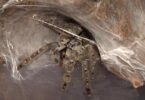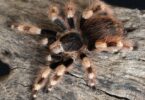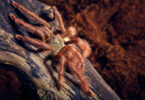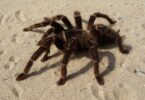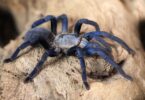Are you ready to meet a real-life mini marvel from the dense forests of Tanzania? The Encyocratella olivacea is not your typical house spider; this rare gem sparkles with an olive touch and a secretive lifestyle.
Our blog post is your treasure map, guiding you through the lush habitat and fascinating life of this Tanzanian Baboon Spider. Stay tuned for a tiny creature with big character!
Description and Lifespan of Encyocratella olivacea
Encyocratella olivacea, often called the Usambara Black-femured Baboon Spider, is an African tarantula with a unique look. Its body has a black and olive hue, and it boasts strong legs tipped with touches of striking orange.
This spider makes its home up in trees as well as down in burrows. It’s quite a sight – females can grow large with their long lifespans reaching up to 12 years! On the other hand, males don’t stick around nearly as long; they usually live about 3 to 4 years.
Habitat of the Usambara Black-femured Baboon
Nestled in the lush, verdant Usambara Mountains of Tanzania, the enigmatic Encyocratella olivacea— the Usambara Black-femured Baboon spider—thrives in a world that’s a mix of both ground and tree-dwelling bliss.
This semi – arboreal tarantula spins its life amidst a tropical climate, where it crafts elaborate silken retreats, shrouded by nature’s dense canopy overhead.
Terrarium Humidity and Temperature
The Usambara Black-femured Baboon needs a special kind of home. To keep one happy, the terrarium environment must be just right.
- Set up the terrarium with the right warmth. In summer, aim for temperatures between 68°F-77°F (20°C-25°C). During winter, keep it cooler at 64°F-68°F (18°C-20°C).
- Watch the water in the air, known as humidity. For these spiders, it should stay high – about 70-80% in the hot months and slightly less at 65-75% when it’s cold.
- Create a comfortable space. The enclosure should be big enough to give them room to move around. At least four times bigger than their size is a good rule.
- Pick the perfect ground covering. A layer of substrate that’s 2-4 inches (5-10 cm) deep will help maintain humidity and provide burrowing space.
- Don’t forget shelter. They need hiding spots to feel secure, so add things like cork bark.
Behavior and Venom Potency of Encyocratella olivacea
When it comes to behavior, the Encyocratella olivacea— Tanzanian Black and Olive Spider —exhibits fascinating characteristics that tarantula enthusiasts find captivating.
Life for the Encyocratella olivacea isn’t just about looking pretty; this African baboon spider has some sass. If you bother them, they get defensive fast and won’t shy away from showing their aggressive side.
But if left alone to do their thing in peace, these spiders spend quiet lives climbing or hiding out in cozy earth tunnels.
Notably stronger venom than its New World cousins, this Old World tarantula packs a punch with its venom, which can result in symptoms similar to those caused by the bite of the Heteroscodra species, including intense pain, nausea, and sweating.
Breeding Details
Breeding the Usambara Black-femured Baboon spider, Encyocratella olivacea, is a challenging task. Yet, it’s fascinating for those who love to study and care for spiders. The details are as follows:
- Mating happens quietly; the male approaches the female with caution because she might attack – It happens very often.
- After successful mating, patience is key; an egg sac appears 2 to 4 months later.
- The female creates a large egg sac, often filled with 50 to 80 eggs; a sign of her hard work.
- Sometimes, females might surprise you with a second egg sac, though this isn’t very common.
- Breeders don’t need to fuss over humidity or temperature to get these spiders ready for breeding – they manage just fine on their own.
Conclusion
The Usambara Black-femured Baboon is indeed a marvel of Tanzania’s wildlife. With its stunning olive and black colors, it catches the eye of many spider lovers. These creatures are unique, living both in trees and on the ground.
They’re a small piece of Africa’s vast natural beauty – amazing yet delicate. Let’s cherish these eight-legged wonders!
FAQs
1. Not much is up about this species, are they still hard to find?
Most individuals of Encyocratella olivacea come from wild capture, which is why it is rarely found in the market and commands high prices, leading to limited available information.
2. Where does the Usambara black-femured baboon live?
It lives in Tanzania, specifically in the Usambara Mountains.
3. How to care for Encyocratella olivacea?
It does not differ significantly from other arboreal species from Africa and thrives well at room temperature
4. How big does this kind of tarantula get?
Encyocratella olivacea reaches a leg span of up to 16 cm.

